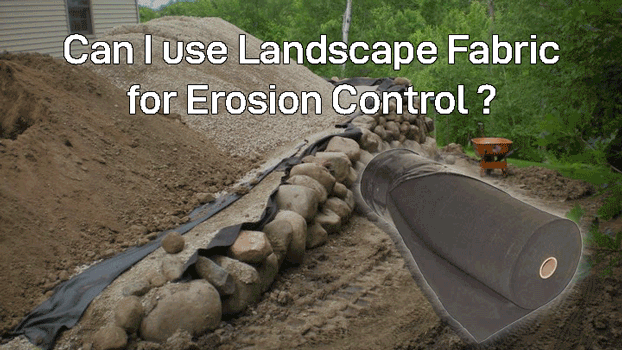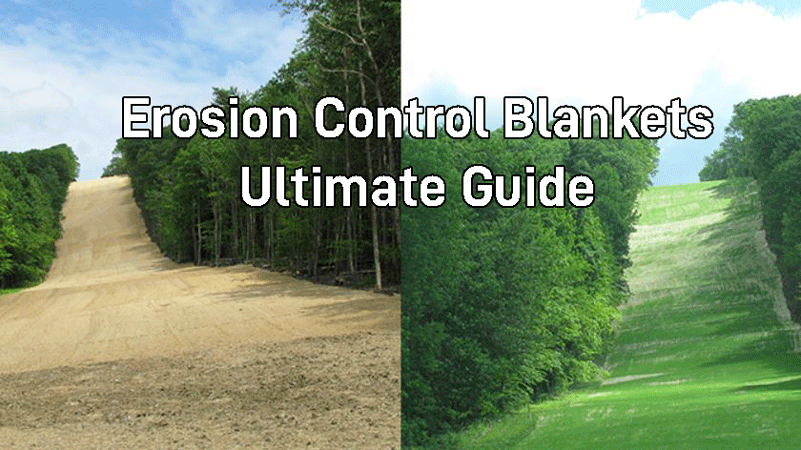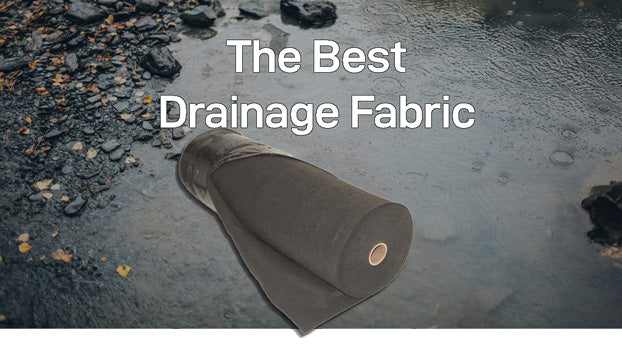Can I use Landscape Fabric for Erosion Control?

A couple of years ago our neighbors built a new home on their property and had concerns that their hillside would erode with all the heavy winter rains during construction. They decided to put down landscape fabric to help mitigate the erosion, but wondered if landscape fabric is best solution for helping prevent erosion.
Geotextile Landscape Fabric can help mitigate soil erosion. Its most effective when buried under 4 inches of soil and used on slopes with 4:1 or less grade. 4:1 slope is 1’ of elevation for every 4’ of distance. Other products like Erosion Control Blankets or Turf Reinforcement Mats are better suited for higher sloped areas.
In this article we'll cover where erosion control fabric is best used for erosion control, and also when its not appropriate, and what other materials should be considered for various scenarios.
How does Landscape Fabric Help Prevent Erosion?
Landscape fabric sometimes called erosion control products helps stabilize soil and provides a layer of protection against erosion. The fabric is laid out over the slope/hillside and soil or aggregate is placed on top.
Sandwiching the fabric between soil helps prevent water from easily washing away the slope and enables a secure place for grass and vegetation to grow. Erosion fabric is best suited for applications on gradual grades.

Roadside being covered with Fabric to help prevent erosion
Landscape fabric helps prevent erosion by both stabilizing the hillside against erosion from rains, and also by providing time and space for grasses and vegetation to grow. Fabric plays a supporting role in this process and can be extremely helpful and easy to implement if your developing a landscape that will withstand erosion.
The greater the slope of the hillside the more likely it will be that other erosion control solutions are required. In general the steeper the hillside or slope the harder it is for grasses and vegetation to fill in and take root.
Ground cover and grasses are an import aspect in preventing erosion as the root network of these plants will stabilize the soil and help water from causing further damage.
What is the Best Type of Landscape Fabric for Erosion Control?
There are two primary geotextiles used for landscaping, Woven Fabric and Nonwoven fabric. Each are useful and are designed with different applications in mind. In general woven geotextile fabric is used where you need a lot of strength and don't require as much drainage (permeability) an example would be driveway matting.
Common Nonwoven Fabric Applications
- Hillside Stabilization & Erosion Control
- French drains, and/or drainage fields
- Rip rap, shorelines, retaining walls
- Pond and water feature construction

Nonwoven Fabric
Common Woven Fabric Applications
- Aggregate or paved driveway stabilization
- Under patios or hardscaping
- Roads, highways, and parking lot construction
- Ground Cover

Woven Geotextile Fabric
Landscape Fabric vs. Slope of the Hillside
Here is an example photo of various grades. Starting at a gradual grade and moving down to 2:1 (50%) slope. understanding your slope is important for knowing if you should be utilizing Erosion Control Fabric or potentially using something else.
For slopes greater than 4:1 grade, other erosion solutions such as Erosion Control Blankets (ECBs), or Turf Reinforcement Mats (TRMs) are going to be a more appropriate solution.
See below for more information on ECB and TRM products.
Slopes over 4:1 grade (25%) are NOT suitable for Landscape Fabric

Visual representation of hill slope
Erosion Control Product Options
Here are 3 things to consider in order to determine if you need to look at other erosion control solutions.
- Slope - Is the slope greater than 4:1? If yes, then use an Erosion Control Blanket (ECB) or Turf Reinforcement Mat (TRM).
- Amount of Rainfall - Is my area known for heavy rain or flash flooding? If yes, then consider using ECB or TRM products.
- Intended Project Duration - Is this a temporary or permanent solution? Depending on the project needs you can consider biodegradable options, or synthetic/permanent options as dictated by the project engineer.
See chart below for project expected timelines:

Other Erosion Control Products:
Erosion Control Blankets
An erosion control blanket sometimes called erosion control matting consists of a matrix of material such as coconut, straw, or wood fiber, that is held together by natural or synthetic fibers. The most common natural fiber used is straw and coconut fiber also known as coir to make a coir mat. These fiber blankets are designed to slow the flow of water and provide a place where seed can grow and re-vegetate the landscape.
Many blankets are considered shorter term with 1-2 years of effective life. These units are typically staked down on hillsides and designed to degrade while providing enough protection for grass seed to grow up through the fibrous matrix. When the blankets fully degrade you're left with the vegetation that will help hold the soil in place.
Curlex erosion control blankets are made from Great Lakes Aspen curled wood fibers which promote ideal growing conditions for grass seed, while also protecting the topsoil from erosion.
You can find the full collection of Erosion Control Blankets here >
Turf Reinforcement Mats
Turf Reinforcement Mats are similar to Erosion Control Blankets except they are engineered as a long term permanent solution. TRMs are typically constructed of synthetic polypropylene matrix and netting and are placed in higher sloped areas. These mats are also useful in high traffic areas or in places that would normally be very challenging to maintain or mow.
The effective life of a typical TRM is 2+ years, but most applications are installed with 5+ years in mind. Similar to ECBs these units are staked down on hillsides and provide great protection for grass seed to grow up through the fibrous matrix.
You can find the full collection of Turf Reinforcement Mats here >
How to Apply Erosion Control Fabric
Installation is not complicated and can be done over a weekend with a bit of work following these steps:
Installing the Landscape Fabric in 3 steps
- Lay out fabric on slope
- Pin fabric down with 6" landscape pins
- apply 4-6 inches of soil/aggregate on top of fabric
Always consult the manufacturers installation guide when installing erosion control products. The Installation Guide for GEOTEX can be found below.
DOWNLOAD FULL GEOTEX INSTALL GUIDE HERE >
NONWOVEN FABRIC APPLICATION SHEET >
Note: if you are resurfacing an asphalt road after completing your project. We also offer paving interlayer fabric which are used as a moisture barrier and stress absorbing interlayer beneath flexible pavements such as asphalt overlays or a chip seal.
If the area you are working is fairly steep, or gets a lot of rain then other products like Erosion Control Blankets or Turf Reinforcement Mats will be a better for your project.
Conclusion
Hillside erosion can be frustrating to deal with, but using Landscape Fabric can help stabilize the soil and provide time for grasses and local vegetation to take root. vegetation root networks are crucial to keeping your hillside from further erosion.
If the area you are working is fairly steep, or gets a lot of rain then other products like Erosion Control Blankets or Turf Reinforcement Mats will be a better for your project.



